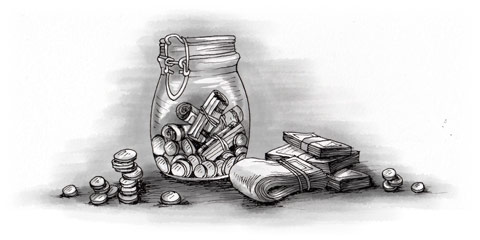Rupee notes come in denominations of 1, 2, 5, 10, 20, 50, 100, 500, 1000. Each note has its value written on it in 17 languages, including English.
Due to the Rupee´s low monetary value, prices can easily reach astronomical numbers. Therefore, Indians use lakh and crore. One lakh equals Rs100,000 and one crore is Rs10,000,000. You should quickly get used to handling these terms as you will encounter them as soon as you look for a place to rent.
Currency exchange in India
It is generally prohibited to import or export Indian Rupees. Only Indian residents going abroad for a short periods of time can bring small amounts of money along. Therefore, you will have to change money in India.
You can exchange money at Indian banks or at private exchange bureaus. Rates at private exchange bureaus are usually slightly better than at banks. You might even be able to negotiate your rate, though this can make the money-exchange a very time-consuming process.
Always keep the receipt of the money exchange, as you need it to transfer Rupees back to your home currency.
Traveler's cheques in India
Traveler's cheques can be exchanged in most Indian banks and larger hotels, but you may have trouble using them in smaller exchange bureaus and in shops in general. To make sure that your traveler's cheques are widely accepted, you should buy cheques from well-known brands, such as American Express. The cheques should be denominated in US Dollars or Pounds Sterling.
Exchange of traveler's cheques in India is always free of charge. If you are asked to pay a fee, you should go and find another exchange bureau.
Debit cards and credit cards in India
Debit and credit cards are becoming more and more common in India. Large hotels, shops, restaurants and also many service providers will accept international credit cards, such as American Express, MasterCard and Visa. They may require a minimum payment of Rs250, however.
Whether your foreign debit card will be accepted depends on the business policies of the respective shop. At small grocery stores, you will still have to pay in cash.
Keep in mind that your bank at home will likely charge you for using your credit card in India. Poor exchange rates, combined with these additional charges can add up to large credit card fees. If you plan on staying in India for some time, consider getting a credit card from an Indian bank. This way you are charged directly in Rupees and do not have to worry about currency exchange rates. However, be aware that getting an Indian credit card involves a lot of red tape.
ATM's in India
ATM's are not yet common in India, although more and more are being installed. They are also not evenly distributed, geographically, so you might have trouble finding ATM's in rural areas.
You can usually use every card that is connected to global payment systems, such as Maestro, MasterCard, American Express and Visa. Some Indian banks charge a foreign exchange fee on ATM withdrawals.
Although ATM's are the most convenient way to withdraw money in India, their withdrawal amounts might be limited. This is especially troublesome if you have to make regular cash payments (i.e. your rent). If your withdrawal is over the ATM limit there is nothing you can do except withdraw money from a bank counter.
Indian ATM's usually pay out in Rs100 and Rs500 notes. In addition, you should always carry some change as you might need it for incidental expenses, such as using rickshaw trips. Rickshaw drivers are usually neither able nor willing to split your bills.

